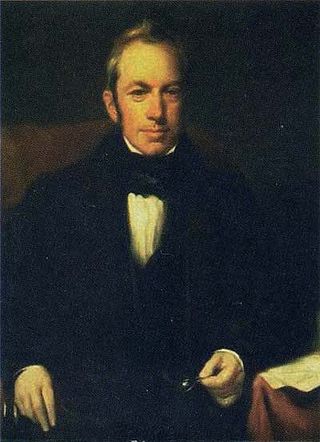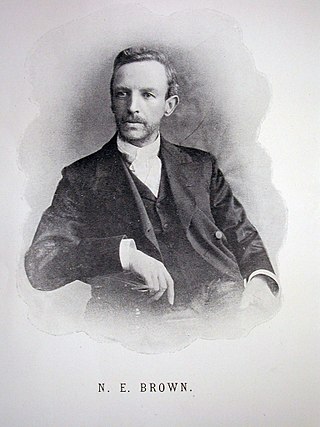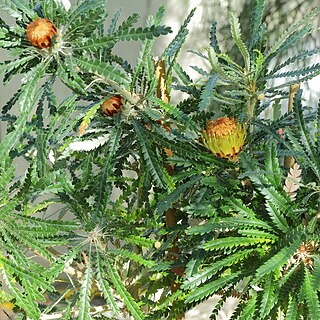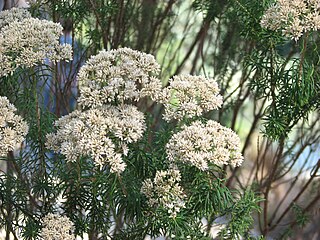
Robert Brown was a Scottish botanist and paleobotanist who made important contributions to botany largely through his pioneering use of the microscope. His contributions include one of the earliest detailed descriptions of the cell nucleus and cytoplasmic streaming; the observation of Brownian motion; early work on plant pollination and fertilisation, including being the first to recognise the fundamental difference between gymnosperms and angiosperms; and some of the earliest studies in palynology. He also made numerous contributions to plant taxonomy, notably erecting a number of plant families that are still accepted today; and numerous Australian plant genera and species, the fruit of his exploration of that continent with Matthew Flinders.
The Linnean Society of London is a learned society dedicated to the study and dissemination of information concerning natural history, evolution, and taxonomy. It possesses several important biological specimen, manuscript and literature collections, and publishes academic journals and books on plant and animal biology. The society also awards a number of prestigious medals and prizes.

Sir James Edward Smith was an English botanist and founder of the Linnean Society.

Richard Anthony Salisbury, FRS was a British botanist. While he carried out valuable work in horticultural and botanical sciences, several bitter disputes caused him to be ostracised by his contemporaries.

William Kirby was an English entomologist, an original member of the Linnean Society and a Fellow of the Royal Society, as well as a country rector, so that he was an eminent example of the "parson-naturalist". The four-volume Introduction to Entomology, co-written with William Spence, was widely influential.

Knightia is a small genus of the family Proteaceae endemic to New Zealand, named in honor of Thomas Andrew Knight. One extant species, K. excelsa (rewarewa) is found in New Zealand. Two further Knightia species are found in New Caledonia, although they were placed in the genus Eucarpha by Lawrie Johnson and Barbara Briggs in their influential 1975 monograph "On the Proteaceae: the evolution and classification of a southern family", a placement supported in a 2006 classification of the Proteaceae. A fossil species from upper Miocene deposits in Kaikorai has been described as Knightia oblonga. Knightia has been placed in the tribe Roupaleae of the subfamily Grevilleoideae.

Xylomelum is a genus of six species of flowering plants, often commonly known as woody pears, in the family Proteaceae and are endemic to Australia. Plants in this genus are tall shrubs or small trees with leaves arranged in opposite pairs, relatively small flowers arranged in spike-like groups, and the fruit a woody, more or less pear-shaped follicle.

Peridiscaceae is a family of flowering plants in the order Saxifragales. Four genera comprise this family: Medusandra, Soyauxia, Peridiscus, and Whittonia., with a total of 12 known species. It has a disjunct distribution, with Peridiscus occurring in Venezuela and northern Brazil, Whittonia in Guyana, Medusandra in Cameroon, and Soyauxia in tropical West Africa. Whittonia is possibly extinct, being known from only one specimen collected below Kaieteur Falls in Guyana. In 2006, archeologists attempted to rediscover it, however, it proved unsuccessful.

Nicholas Edward Brown was an English plant taxonomist and authority on succulents. He was also an authority on several families of plants, including Asclepiadaceae, Aizoaceae, Labiatae and Cape plants.

Gompholobium, commonly known as glory peas or wedge-peas, is a genus of plants in the pea family Fabaceae and is endemic to Australia. Most species have compound leaves composed of three leaflets and all have ten stamens which are free from each other and a distinctive arrangement of their sepals.

Banksia formosa, commonly known as showy dryandra, is a species of shrub that is endemic to the south-west of Western Australia. It has pinnatipartite leaves with up to forty triangular lobes on each side, up to more than two hundred, conspicuous golden orange flowers and up to sixteen egg-shaped follicles in each head.

Banksia obtusa, commonly known as shining honeypot, is a species of shrub that is endemic to the south-west of Western Australia. It has underground stems, linear pinnatifid leaves with triangular lobes on each side, cream-coloured to yellow flowers in heads of up to seventy, surrounded by dark reddish bracts and egg-shaped follicles.

On the natural order of plants called Proteaceae, also published as "On the Proteaceae of Jussieu", was a paper written by Robert Brown on the taxonomy of the plant family Proteaceae. It was read to the Linnean Society of London in the first quarter of 1809, and published in March 1810. It is significant for its contribution to the systematics of Proteaceae, and to the floristics of Australia, and also for its application of palynology to systematics.

Franklandia is a genus of small shrubs in family Proteaceae, commonly known as lanolin bushes. It is endemic to Southwest Australia.

Cassinia aculeata, commonly known as common cassinia, dolly bush or dogwood , is a species of flowering plant in the family Asteraceae and is endemic to south-eastern Australia. It is an erect shrub with sessile, linear, variably-sized leaves, and heads of creamy-white to white flowers arranged in rounded cymes.
George Jackson (1780–1811) was an English botanist and author. He was born in Aberdeen in 1780 and was later in charge of A.B. Lambert's herbarium. On 2 February 1808 he was elected a Fellow of the Linnean Society and made important contributions to the Henry Cranke Andrews publication The Botanist's Repository. He formally described the genus Ormosia, publishing the description in Transactions of the Linnean Society.

Cerro de la Neblina, also known as Serra da Neblina in Brazil and Sierra de la Neblina in Venezuela, is a sandstone massif located in the northern Amazon Basin. It is a tilted, heavily eroded plateau, with a deep canyon in its central portion, drained by the Baria River.
Bassett Maguire was an American botanist, head curator of the New York Botanical Garden, and a leader of scientific expeditions to the Guyana Highlands in Brazil and Venezuela.
Maguireothamnus is a genus of flowering plants belonging to the family Rubiaceae.
Tibouchina fraterna is a species of flowering plant in the family Melastomataceae, native to Guyana and south Venezuela. It was first described by Nicholas Edward Brown in 1901. The type specimen is kept in the herbarium at the Berlin Botanical Garden and Botanical Museum. One chromosome count has been done for this species with a gametophytic count of 9.















